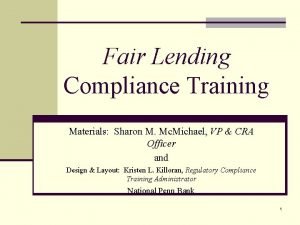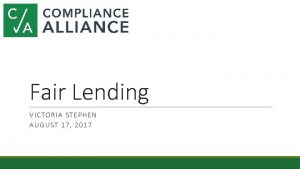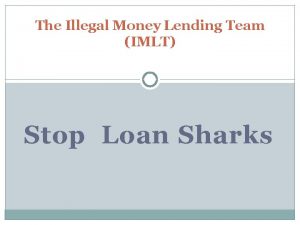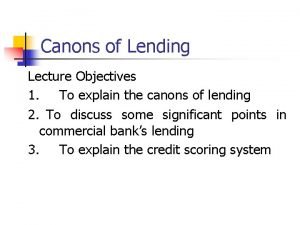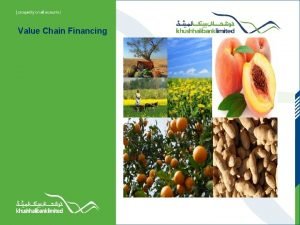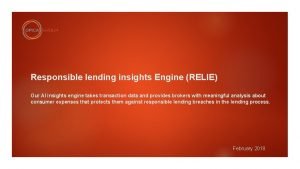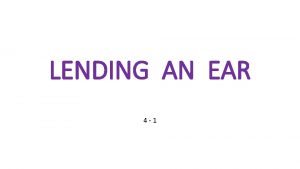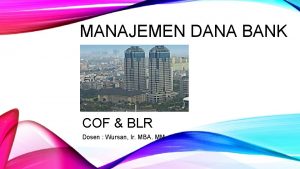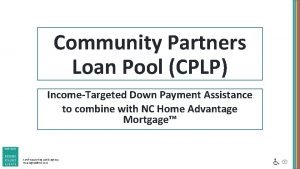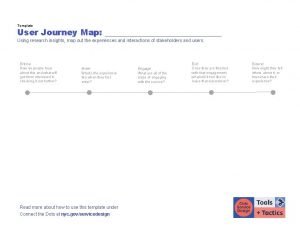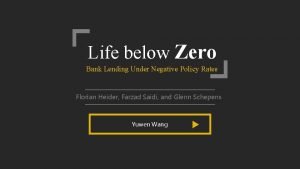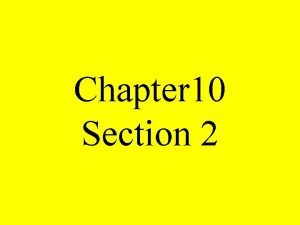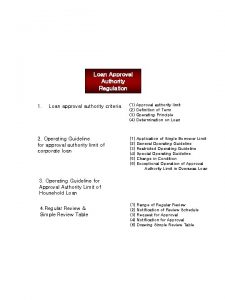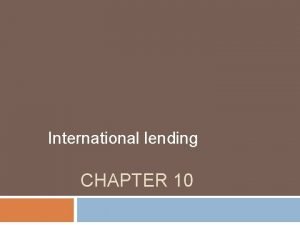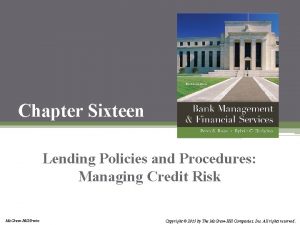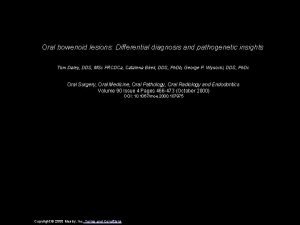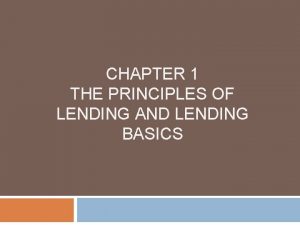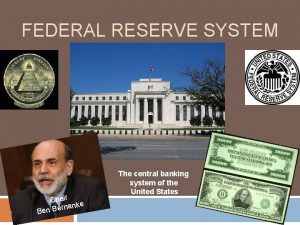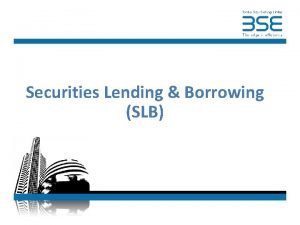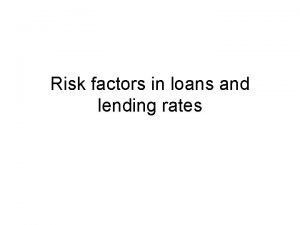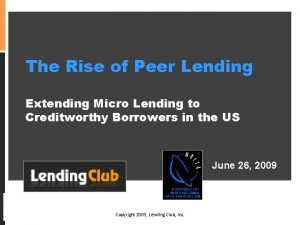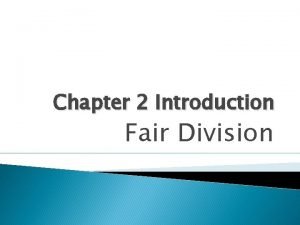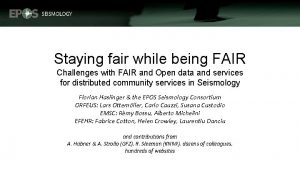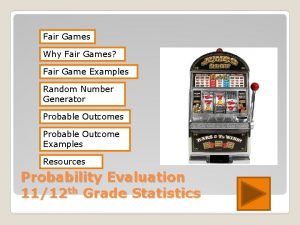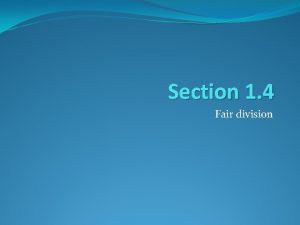Fair Lending VICTORIA STEPHEN AUGUST 17 2017 Agenda




































- Slides: 36

Fair Lending VICTORIA STEPHEN AUGUST 17, 2017

Agenda § § § Overview of Fair Lending Laws Compliance Management System Risk Indicators & Risk Mitigation Hot Topics & Enforcement Actions Question & Answer 2

Overview

Overview § Fair Lending Laws & Regulations § Prohibited Bases § Types of Discrimination 4

Overview: Fair Lending Laws 1. Equal Credit Opportunity Act (ECOA) 2. Fair Housing Act (FHA) § § § Apply to banks and any third parties with whom the bank contracts. Apply to all phases of the lending process. Include extensions of credit to corporations, partnerships, trusts, etc. 5

Regulations: Equal Credit Opportunity Act (ECOA) • Regulation B, CFPB Part 1002 • Prohibits discrimination in any aspect of any credit transaction. 6

Regulations: Fair Housing Act (FHA) • FDIC 12 CFR 338 & HUD 24 CFR 100 • Prohibits discrimination in all aspects of “residential real-estate related transactions. ” • Examples (not exhaustive): • Making loans to buy, build, repair, or improve a dwelling; • Purchasing real estate loans; • Selling, brokering, or appraising residential real estate; or • Selling or renting a dwelling. 7

Prohibited Bases: Comparison ECOA FHA Race Color Religion National Origin Sex Marital Status* Handicap* Age* Familial Status* Receipt of income from public assistance program* Exercise of rights under Consumer Credit Protection Act or state law* 8

Types: Disparate Treatment - Overt • Lender openly discriminates on a prohibited basis • Note: Includes lender expression of discriminatory preference even if the lender does not actually act on the expressed preference. Example: An MLO tells a customer, “We do not like to make home mortgages when a woman is the only borrower, but the law says we cannot discriminate and so we have to comply with the law. ” 9

Types: Disparate Treatment - Implied • Lender treats applicant differently based on one or more of the prohibited bases. • Note: Implied disparate treatment does not require a conscious intention to discriminate beyond treatment itself. Example: Two individuals with same credit issues submit applications. Lender discusses credit report with non-minority applicant, identifies error in the report, and grants credit. Lender then denies minority applicant with no opportunity to discuss potential credit report error. Borrower Loans Avg. Int. Rate Minority 20 15% Non-minority 30 5% 10

Types: Disparate Impact • Neutral policy or practice that is applied equally, but disproportionately excludes or burdens persons on a prohibited basis • Three-step analysis: 1. Disproportionately burdens persons/groups on prohibited basis? 2. Justified by “business necessity”? 3. Alternative policy/procedure available with no or less discriminatory effect? Example: Lender’s policy prohibits single -family residential loans for less than $200, 000. 11

Compliance Management System

CMS: Oversight § Purposes: 1. 2. Set out compliance program Show commitment to Fair Lending compliance § Duties can be delegated, but Board is ultimately responsible for compliance § Board and Management oversight § § § Fair Lending risk assessment Be familiar with products and services Be aware of lending data 13

CMS: Program • Policies and Procedures • Lending and Fair Lending policies • Practiced procedures • Training • Board, management, and staff • Monitoring • Ongoing and periodic monitoring processes 14

CMS: Audit § Very much based on individual risk § Periodic Fair Lending audits § Self-evaluations § Self-tests § If implemented: § Report results to Board § Implement follow-up processes “A self-test is any program, practice, or study that: 1. Is designed and used specifically to determine the extent or effectiveness of a creditor's compliance with the Act or this part; and 2. Creates data or factual information that is not available and cannot be derived from loan or application files or other records related to credit transactions. ” 15

Risk Indicators & Mitigation

Risk Indicator: Overt Indicators § Specific mention of a prohibited basis group § Including variables in credit scoring system that rely on prohibited basis § Making statements (employees or agents) reflecting discrimination or attitudes based on prohibited bases § Example: Account X (anyone of legal age) Account Y (50 and older) $10 service charge, no minimum balance $200 overdraft protection 5% HELOC interest rate 4% HELOC interest rate 17

Risk Mitigation: Overt Indicators § Review new or amended policies for compliance with fair lending laws § Establish/ evaluate internal controls, including monitoring § Train staff involved in any aspect of lending on both the fair lending laws and the bank’s lending policies § Clearly communicate responsibilities and expectations to ensure consistency across the bank 18

Risk Indicator: Underwriting Indicators § § § Significant denial rate disparity on prohibited bases Vague terms for underwriting standards High rate of exceptions to policy Limited to no documentation in loan file to support decisions. Example: Maximum DTI of 36% Approved Denied Female 25 of 50 Male 10 of 50 40 of 50 19

Risk Mitigation: Underwriting Indicators § Develop specific and objective underwriting criteria to ensure the bank (and third-party underwriters) consistently apply underwriting policy § Implement policies and procedures requiring loan officers to document credit decision in loan files § Review policy exceptions and evaluate whether loan officers document exceptions and the reasons they were made. § Perform comparative file analysis of denials and approvals. 20

Risk Indicator: Pricing § § § § Broad discretion in pricing, including rates and fees Disparities in rates and fees on prohibited bases Risk-based pricing without objective criteria Risk-based pricing applied inconsistently Disparities in rate spreads (HMDA data) Example: Brokers Example: Auto Dealers 21

Risk Mitigation: Pricing § Monitor loan pricing to identify possible pricing disparities and rate sheet deviations § Monitor broker lending patterns and compensation § No rate sheet: § Internal controls § Regular monitoring and training § Clearly communicate responsibilities and expectations § Appropriate loan documentation in either case § Focus pricing reviews on discretion allowed and determine whether controls are adequate to mitigate level of lending risk. 22

Other Indicators § Redlining § Steering § Marketing 23

Indicator: Redlining § Form of illegal disparate treatment § Bank provides unequal access to credit or unequal forms of credit because of a prohibited basis based on where the applicant resides. § Reverse Redlining: targeting certain borrowers or areas with less beneficial products or services based on prohibited characteristics. § Like any other disparate treatment, Redlining can be proven with either overt or comparative evidence. 24

Indicator: Steering § Increased products and/or channels increases risk that applicants will be illegally steered into certain choices based on prohibited characteristics rather than the applicants’ needs. § Note: financial harm need not occur. It is sufficient that the action was taken on a prohibited basis. 25

Indicator: Marketing § Marketing efforts show clear decisions to include or exclude certain areas. § Marketing patterns, generally, will either support or contradict the case that disparities in other lending practices were intentional. § Note, however, that marketing can rise to the level of being an indicator in itself. If there is enough evidence, marketing to clearly racially different areas, for example, could itself be treated as a redlining violation. 26

Hot Topics & Enforcement Actions

Hot Topics: Redlining § Whether lenders have intentionally discouraged prospective applicants in minority neighborhoods from applying for credit. § “…a form of illegal disparate treatment in which a lender provides unequal access to credit, or unequal terms of credit, because of the race, color, national origin, or other prohibited characteristic(s) of the residents of the area in which the credit seeker resides or will reside or in which the residential property to be mortgaged is located. ” 28

Hot Topics: Redlining § § § Strength of CMS; Unique attributes of relevant geographic areas; Lending patterns ; Physical presence; Marketing; Mapping; Peer and market comparisons; CRA assessment area and reasonably expected market area (REMA); Lending policies and procedures record; Additional evidence; and Explanations for apparent differences in treatment. 29

Hot Topics: Small Business Lending § Concern that women-owned and minority-owned businesses may experience discrimination when applying for credit. § Section 1071 of the Dodd-Frank Act requires financial institutions to track and report applications made by women-owned, minority-owned and small businesses. § 05/15/2017: CFPB published a Request for Information asking for feedback to help develop implementing regulations § Original comment period was July 14, but was subsequently extended 60 days to September 14. 30

Hot Topics: Small Business Lending § § § Small Business definition Data Points Institutions Engaged in Business Lending Access to Credit and Financial Products Privacy 31

Hot Topics: Mortgage and Student Loan Servicing § Whether some borrowers who are behind on their mortgage or student loan payments may have more difficulty working out a new solution with the servicer because of their race, ethnicity, sex, or age. § Areas of concern: misusing escrow funds, vague periodic statements, deceptive statements about interest capitalization during deferment, erroneous deferment terminations, among others. 32

Hot Topics: Limited English Proficient (LEP) Consumers § ECOA requires “the fair, equitable, and nondiscriminatory access to credit” and promotion of “the availability of credit. ” Accordingly, CFPB continues to encourage lenders to provide assistance to LEP consumers. § Issue: Marketing only some of their available credit card products to Spanishspeaking consumers, while marketing several additional credit card products to English-speaking consumers, without adequate documentation. § Mitigation: Revise marketing materials to notify consumers in Spanish of availability of other credit card products and include clear and timely disclosures to prospective consumers describing the extent and limits of any language services provided throughout the product lifecycle. § Synchrony Bank enforcement action 33

Enforcement Actions § Bancorp. South Bank (June 29, 2016) § § Redlined Discriminated in underwriting Discriminated in pricing Implemented directly discriminatory denial policy 34

Resources § § § § § Revised FFIEC Interagency Fair Lending Examination Procedures Appendix Equal Credit Opportunity Act Regulation B, 12 CFR 1002 Fair Housing Act 12 CFR 338, Fair Housing 24 CFR 100, Discriminatory Conduct Under the FHA CFPB Fair Lending Report Compliance Alliance Fair Lending Toolkit 35

Questions? Thank you for your participation! We hope you found value in the presentation. If you have any additional questions, contact Compliance Alliance at hotline@compliancealliance. com or 888 -353 -3933. 36
 Fair lending compliance training
Fair lending compliance training Ffiec fair lending examination procedures appendix
Ffiec fair lending examination procedures appendix Centros alternativos de los 7 habitos
Centros alternativos de los 7 habitos 1260 days
1260 days Fair is foul and foul is fair
Fair is foul and foul is fair Sonnet poem 14 lines
Sonnet poem 14 lines What is syntax rhetorical device
What is syntax rhetorical device Foul is fair and fair is foul literary device
Foul is fair and fair is foul literary device Fair play slide
Fair play slide Macbeth stylistic devices
Macbeth stylistic devices Examples of fair is foul and foul is fair in macbeth
Examples of fair is foul and foul is fair in macbeth Stephen covey agenda
Stephen covey agenda Gartner cio forum
Gartner cio forum Agenda sistemica y agenda institucional
Agenda sistemica y agenda institucional Student lending analytics
Student lending analytics Illegal money lending team
Illegal money lending team Relie responsible lending and insights engine
Relie responsible lending and insights engine Principles of lending
Principles of lending Canons of lending
Canons of lending Vcf financing
Vcf financing Sound lending principles
Sound lending principles Relie check
Relie check Relie responsible lending and insights engine
Relie responsible lending and insights engine Lending
Lending Cara menghitung blr
Cara menghitung blr Cplp loan
Cplp loan Relie responsible lending and insights engine
Relie responsible lending and insights engine Life below zero: bank lending under negative policy rates
Life below zero: bank lending under negative policy rates An institution for receiving, keeping, and lending money
An institution for receiving, keeping, and lending money Relie responsible lending and insights engine
Relie responsible lending and insights engine Credit approval authority
Credit approval authority Forms of international lending
Forms of international lending Lending policies and procedures managing credit risk
Lending policies and procedures managing credit risk Relie responsible lending and insights engine
Relie responsible lending and insights engine Levy brief jblm
Levy brief jblm Basic principles of lending
Basic principles of lending Fractional reserve theory
Fractional reserve theory
